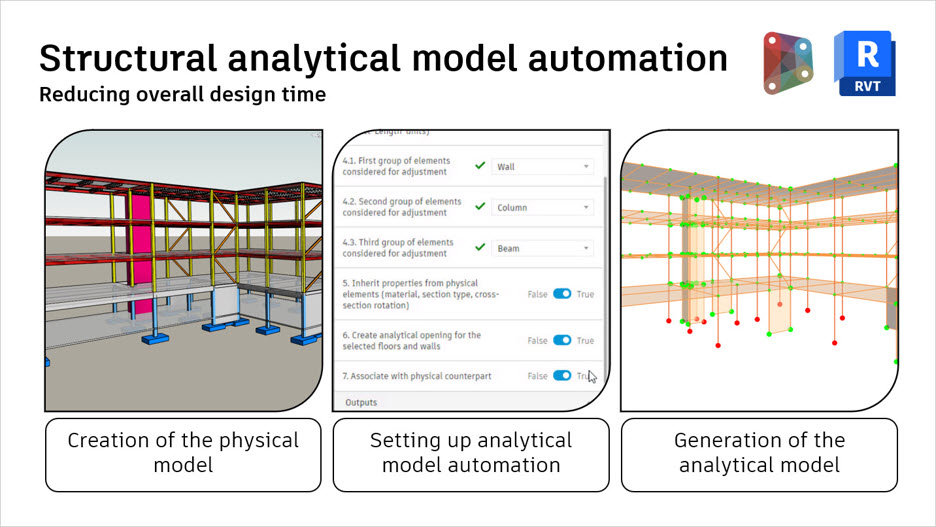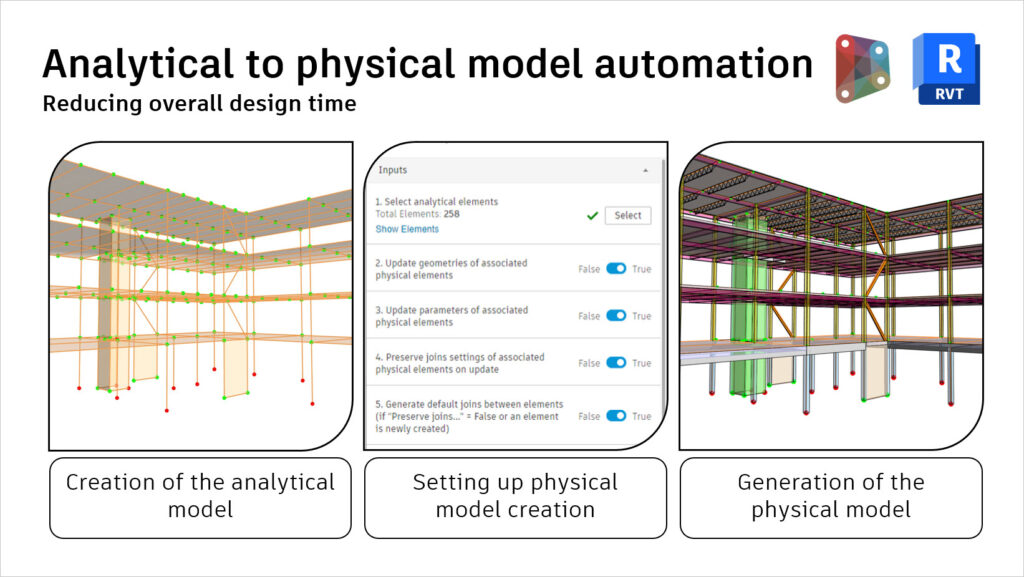& Construction

Integrated BIM tools, including Revit, AutoCAD, and Civil 3D
& Manufacturing

Professional CAD/CAM tools built on Inventor and AutoCAD
7 min read
As more and more structural engineers embrace Building Information Modeling (BIM) workflows, demand is increasing for analytical collaboration in BIM.
The development of a structural analytical model is an essential step in a structural engineer’s BIM process. This model is often used in collaborative workflows across engineering teams.
For many years now, Autodesk Revit has offered features for structural analytical modeling. But those features did not provide structural engineers with enough flexibility and control in the modeling process, especially for non-standard and complex structures.
For example, an engineer might want to modify the position of a physical model easily without changing the geometry and position of the associated analytical model—but these were directly linked in the past.
At the same time, we know that engineers want to ensure that their physical and analytical models remain well coordinated throughout the design process.
To that end, Revit 2023 has introduced a completely new approach to structural analytical modeling. The workflow has been totally reimagined to help engineers use Revit to coordinate across structural physical and analytical models and drive BIM-centric analysis workflows.
As before, you can leverage existing physical geometry in 2D and 3D views as context for the analytical model. The analytical model remains associated to physical geometry but is now independent, providing you with the benefits of speed and accuracy in model creation while protecting the analytical model from unexpected changes. This new approach to structural analytical modeling enables you to create representations for any type of structure—buildings, frames, pavilions, bridges, stairs and more. You can create consistent analytical models that align with your preferred engineering approach.

You might be thinking, “Wait a minute…does this mean I will have to put in twice as much work (authoring separate physical and analytical models)?”
Not at all! This new analytical modeling approach was introduced together with rules-based Structural Analytical Model Automation features to automate certain processes. This new solution ensures that automatically-created models remain consistent and connected, eliminating the need for tedious corrections and rework.

Dynamo for Revit contains a collection of dedicated nodes for structural automation
At present, two main workflows are supported with dedicated out-of-the-box Dynamo scripts:


The Physical to Analytical Automation Dynamo script offers many options for customization, including analytical adjustments prioritization per structural category and connectivity tolerances.
You can designate a first, second, and third priority element hierarchy. This is useful, for example, when prioritizing column locations over beam locations. First priority elements are the main elements, meaning that second and third priority elements will snap to them. Likewise, third priority elements will snap to first and second priority elements.
You may specify a tolerance for the distance between analytical elements. This feature also allows you to create associations between newly created analytical elements and physical counterparts. You can also choose to have analytical elements inherit their properties from associated physical elements, such as material, section type, and cross-section rotation. You can specify whether analytical openings should be created for selected floors and walls.

Finally, once the analytical model has been generated, it can be updated easily based on changes to the physical model.
This automated process significantly improves the creation of analytical model(s) associated to the physical model and ready for analysis.
Moreover, the automation logic can be easily customized to specific project types, e.g. buildings, pre-engineered metal buildings, roofing structures, bridges, etc. And those who are skilled in computational design and automation can edit and extend these scripts in Dynamo.
When your analytical model is finalized, it can be transferred to Robot Structural Analysis Professional for analysis and code-based design. The link between Revit 2023.1 and Robot Structural Analysis Professional 2023.1 software has been updated to reflect the changes that have been made to analytical modeling in Revit. The recent update of the link includes several enhancements:

Once you have completed the structural analysis and design in Robot, this information can be sent to Revit to update the model and documentation.
The new analytical model remains associated with physical geometry but is now fully independent, having its own set of properties such as section type, material, etc. Therefore, when you update the Revit model after the code design process in Robot (bringing information about updated cross-sections), you will notice that the physical section types (in the Revit model) are not automatically updated. Only the analytical model section type properties are updated.
This is not a problem, as the physical and analytical models are associated with each other. This is the situation where the second Dynamo script (Analytical to Physical Automation) can be used. As mentioned previously, this script can be used to update the physical model using the analytical model as context.
Some projects are started from the analytical representation of the model. Probably the most revolutionary capability when it comes to the BIM-centric workflows for structural analysis offered by Autodesk is the fact that you can now start modeling with analytical intent. As the analytical model is now completely autonomous, you can choose to initiate structural analysis workflows from Revit without any physical context.
For example, when starting a project from scratch, you can focus exclusively on analytical modeling—just like you would in traditional analysis software.

However, the creation of physical elements based on this analytical model might be tedious work if not automated. In addition to updating the physical model based on code-checking design results, the creation of associated physical model geometry from a structural analytical model using on-demand, configurable rules speeds up your modeling process.

Using the analytical model as context, you can easily generate physical elements and connect them, defining associations between the models automatically.

Moreover, you can choose to start your modeling process in Robot Structural Analysis Professional, developing your structural geometry (analytical model) from scratch and then send the model to Revit.

As you can see, the new analytical model in Revit introduces not only more flexibility and control over the analytical model, but also brand new workflows, giving structural engineers the ability to choose their preferred approach to structural design and analysis.

While creating the analytical representation for a Revit model manually, you need to associate each analytical element with its physical context. Prior to the 2023.1 release of Revit, you could only create this association manually—after creating each analytical element. When enabled, the Assisted Association command automatically identifies the physical element that is overlapped by the newly-created analytical elements and creates the association between them with no additional clicks.

The Assisted Association command evaluates the intersection between the boundary boxes of the analytical and physical elements. If more than 70% of the boundary box of the analytical element intersects the box of the physical one, an association between these two will be created. The value of the box intersection percentages is hardcoded. This automated association offers you greater productivity when you model for analysis within the context of a physical model.
If you are a Dynamo user who creates your own custom scripts from scratch, you may want to install the latest version (2022.12) of the Structural Design Dynamo package. That version contains a set of additional nodes that complement out-of-the-box analytical model automation in Revit 2023.1.

This collection of Dynamo nodes supports the creation of analytical models in Revit from scratch. Using the AnalyticalMember.ByCurveAndProperties node, you can create parametric Dynamo geometry and then use it to generate the analytical model. This node also gives you the ability to assign all critical properties to analytical members, such as structural role, structural material, section type, and cross-section rotation.
If you prefer to use the location line of a physical framing element over the actual position of a physical element, you may find the AnalyticalMember.ByElementLocationLine useful. Here is a snapshot of the Structural Design Dynamo nodes that support the automation of analytical models in Revit.

At Autodesk, we are prioritizing workflows and capabilities that will help prepare structural professionals both for the challenges of today and the buildings of tomorrow. The new approach to structural analytical modeling described in this article represents just one example of the investments we are making for structural engineers. Stay tuned…there will be more to come!
By clicking subscribe, I agree to receive the AEC newsletter and acknowledge the Autodesk Privacy Statement.
Success!
May we collect and use your data?
Learn more about the Third Party Services we use and our Privacy Statement.May we collect and use your data to tailor your experience?
Explore the benefits of a customized experience by managing your privacy settings for this site or visit our Privacy Statement to learn more about your options.